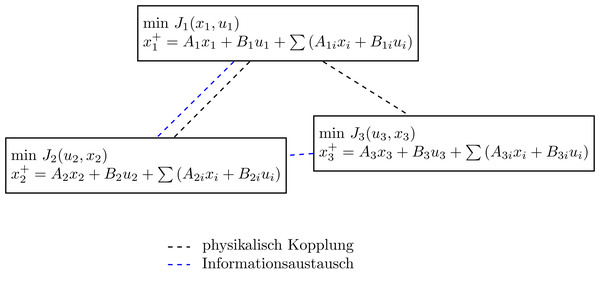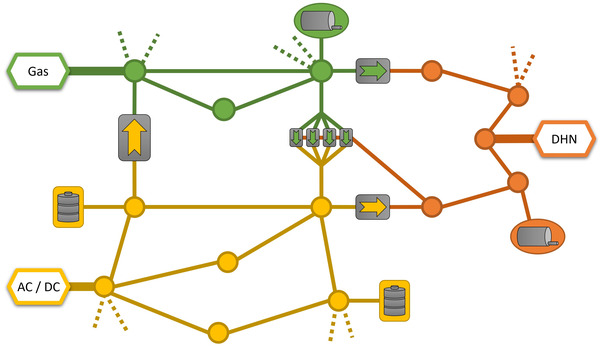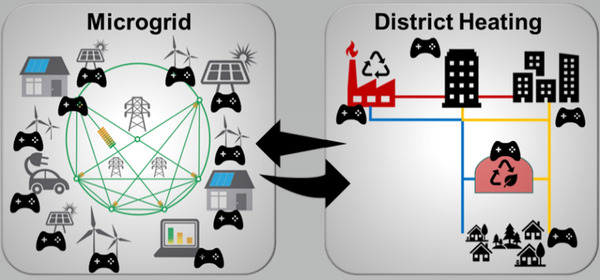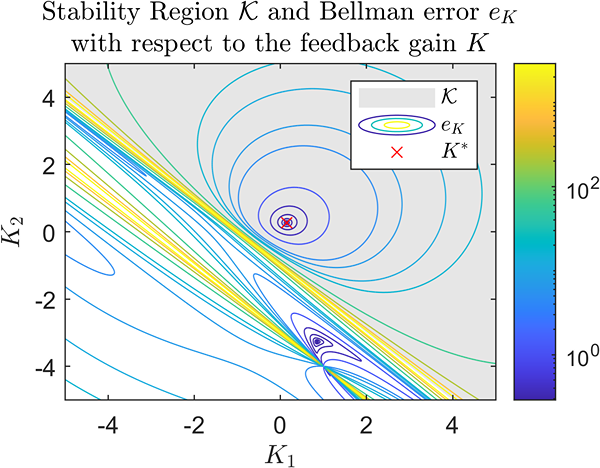Coupled multi-agent systems and distributed optimal controls
For reasons of sustainability and due the climate emergency, an energy transition towards renewable energy is taking place throughout the world. In 2018, 38% of the electrical energy consumed in Germany was generated by renewable energy. According to the German law EEG, renewable energy has to account for 80% of the total electrical energy needs of Germany in 2050. Thus, conventional power plants are being steadily replaced by a huge amount of generators based on renewable energy resources.
These huge amount of generators form, together with flexible loads and other components, microgrids. The control of such microgrids (frequency and voltage) is already well explored. However, the benefits of an interconnection of various microgirds remains unexplored. Research is aimed at the study of such an interconnection from a system theoretic point of view. Especially, fundamental importance will be given on the information that needs to be shared and the kind of optimality achieved by an interconnection.
Contact: M. Sc. Pol Jané Soneira
High Level Plug-and-Play-Based Control Strategies for Multi-Carrier Energy Systems
Multi-Carrier Energy Systems: Future energy systems will no longer simply comprise the disjointed electricity, heating and gas networks, but will instead focus on an interconnected, holistic approach. The aim of a joint consideration of these energy systems is the increased the robustness and flexibility achievable by balancing out the energy surpluses or deficiencies amongst the various energy systems. In light of the accelerating trend towards renewable energy sources (RESs) in the electrical grid especially, interconnecting the various energy domains provides a potential means of compensating for the inherent intermittency with which RESs generate power.
Plug-and-Play: Due to the large number of RESs needed to satisfy current and future electricity demands, the tried and tested centralised control structures traditionally used for regulating large power stations are unsuited for an electrical grid dominated by numerous sources spread out over a large distance. Similar to the peripherals of modern computer, a Plug-and-Play compatible approach would allow energy sources to connect to and disconnect from the energy networks seamlessly and without a central authority required to govern and configure the sources.
High Level: Beyond simply regulating the fundamental variables of the energy networks (e.g. the voltages and frequency for the electrical grid), high-level objectives – such as the interaction and coordination of components in and among the various energy systems and considerations for the flow of power – must be considered to realise efficient and symbiotic interactions between the various energy systems.
Contact: M. Sc. Albertus Malan
Decentralized, Passivity-Based Control of Networked Multi-Energy Systems
A sustainable energy supply requires to rethink energy systems. In order to achieve true climate neutrality, not only electrical power grids, but networked multi-energy systems consisting of electricity, district heating, gas, hydrogen, etc. grids have to be considered. In my research, I develop decentralized control methods for components such as generators, consumers, and storage devices in different energy grids. For this, I exploit the unifying, generalizing property of physical-based methods (e.g. generalized equivalent circuits, port-Hamiltonian systems), the modularity of the system property of "passivity", and its relation to Lyapunov stability. The control methods developed in this way are modular and scalable, allowing to cope with the very high complexity of networked multi-energy systems.
In particular, the increasing number of components (generators, consumers, storage devices) that dynamically interact with each other at an ever-faster rate (i.e. on smaller time scales) due to the integration of renewable technologies can thus be managed. Components can be connected or disconnected without adapting the controllers of other components or jeopardizing stability ("plug-and-play").If you are interested in a research collaboration (for PhD students), a bachelor’s or master’s thesis, a Hiwi job, or a research internship, please do not hesitate to contact me. Besides the open calls, there is usually always something to do.
Contact: M. Sc. Felix Strehle
Policy Optimization Methods for Linear Quadratic Regulator
My research focuses on innovative policy optimization methods for the continuous-time Linear Quadratic Regulator (LQR) problem with an infinite time horizon. One part of this work involves the development of dynamic state-feedback controllers, known as policy gradient flows, that efficiently solve the LQR problem. These dynamic controllers can stabilize polytopic linear parameter-varying systems even in the presence of abrupt parameter changes. This approach enables online solutions to the time-varying LQR problem, thereby improving the transient performance of the closed-loop system.
In addition, I develop data-driven policy optimization methods that learn optimal feedback directly from measured input and state data without explicit system identification. In this context, I investigate both behavioral system parameterizations and integral reinforcement learning approaches, from which I develop novel data-driven gradient flows, policy iterations, convex optimization methods, and a data-driven continuous-time algebraic Riccati equation. My work bridges classical control methods, reinforcement learning techniques, and data-driven approaches.
Contact: M. Sc. Armin Gießler





